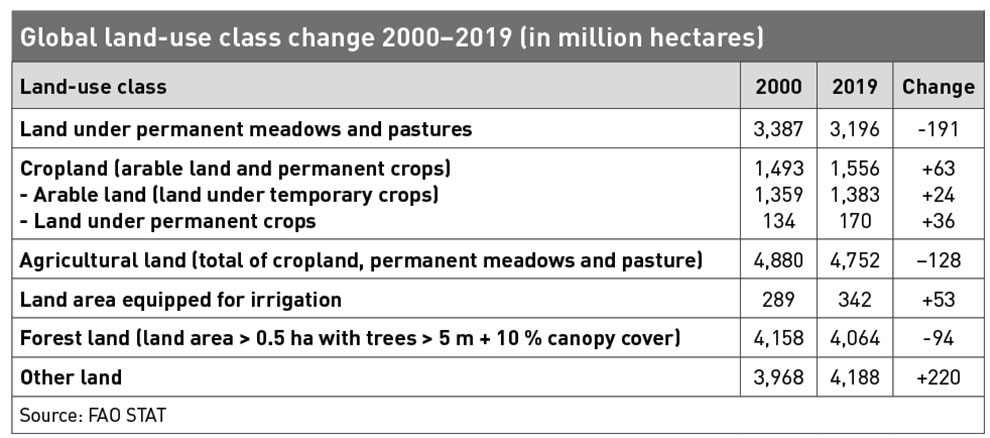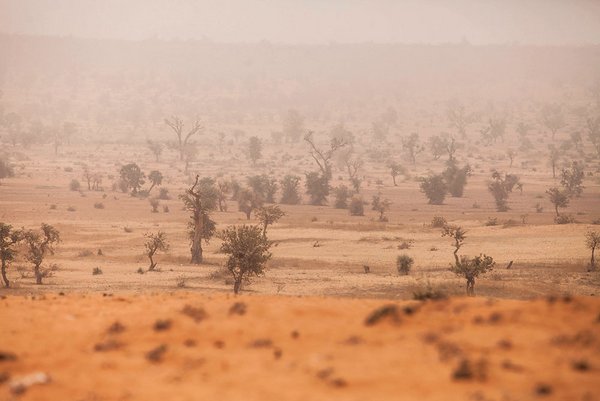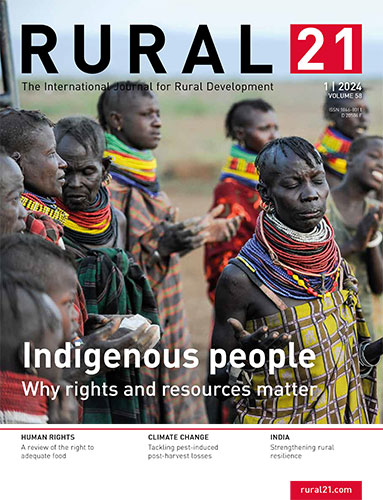 Download this article in magazine layout
Download this article in magazine layout
- Share this article
- Subscribe to our newsletter
Facts and figures on land and soil
DEFINITIONS
Land degradation: The persistent or long-term loss of land-based natural capital. Land degradation affects all types of land, from cities and rangelands to farmland and wilderness. While often quite evident on the surface, it is the hidden and insidious deterioration in the physical, chemical, and biological properties of soil, water and biodiversity that is undermining human health and economic prosperity.Land becomes degraded in many ways. Some are natural or indirect, but most result from direct human activities.
For example:
- people cut down forests for timber and fuelwood or to grow crops and graze livestock;
- grasslands or drained wetlands are converted to cultivate food or expand urban areas;
- mining and infrastructure contribute to land degradation in both urban and rural areas;
- in the drylands, the over-exploitation of soil, water and vegetation results in desertification.
Land degradation neutrality: A state whereby the amount and quality of land resources necessary to support ecosystem functions and services and enhance food security remain stable or increase within specified temporal and spatial scales and ecosystems. Land degradation neutrality aims to balance anticipated losses in land-based natural capital and associated ecosystem functions and services with measures that produce alternative gains through approaches such as land restoration and sustainable land management. The goal is maintaining or enhancing the land resource base – in other words, the stocks of natural capital associated with land resources and the ecosystem services that flow from them.
Land restoration: A continuum of sustainable land and water management practices that can be applied to conserve or “rewild” natural areas, “up-scale” nature-positive food production in rural landscapes and “green” urban areas, infrastructure and supply chains. It can be active (such as planting grasses, shrubs, and trees or managing soils and wildlife), or passive (such as allowing land to recover by itself after disturbance).
Regenerative agriculture: The use of techniques that restore soil health and protect water and biodiversity by controlling soil erosion, reducing tillage and the use of agrochemicals, and adopting integrated systems of crops, trees and livestock, in addition to a wide array of other farm restoration measures.
Sustainable land management: The use of land resources, including soils, water, animals and plants, for the production of goods to meet changing human needs, while simultaneously ensuring the long-term productive potential of these resources and the maintenance of their environmental functions.

INTERNATIONAL AGREEMENTS
Rio Conventions: At the Earth Summit 1992 in Rio de Janeiro, Brazil, three global agreements were adopted: the Convention on Biological Diversity (CBD), the United Nations Convention to Combat Desertification (UNCCD) and the United Nations Framework Convention on Climate Change (UNFCCC). The Conventions work together to ensure that land, climate and biodiversity benefit from a joint approach to restore our balance with nature. In 2001, the secretariats of the Rio Conventions established a Joint Liason Group to collect and share information on work programmes and operations of each convention.
UN Decade on Ecosystem Restoration: Preventing, halting and reversing the degradation of ecosystems world-wide is the focus of the UN Decade on Ecosystem Restoration (2021–2030). It calls for a broad and balanced response, addressing all ecosystems and their connectivity to re-establish a healthy landscape mosaic. These efforts are closely aligned with Sustainable Development Goal (SDG) target 15.3, which calls on countries to strive for land degradation neutrality by 2030.
THE GENDER ASPECT OF LAND USE AND LAND DEGRADATION
In many countries, women have unequal and limited opportunities to access or own land in their name. According to data from the 2019 OECD Social Institutions and Gender Index,
- even in countries where women have the same legal rights as men to own and access land – as is the case in Costa Rica – only 15.6 per cent of farm ownership is in the hands of women;
- in Central Asia and the Caucasus, despite legal gender equality under law, women own on average only 23 per cent of land;
- in the Middle East and North Africa, only 4 per cent of women hold land titles;
- disinheritance of the surviving spouse still occurs in 96 countries;
- women’s rights to inherit their husbands’ property are denied in 102 countries under customary, religious or traditional laws and practices; 103 countries do not criminalise property dispossession or grabbing of inheritance;
- not having land titles that can be used as collateral or the lack of secure tenure hinder women’s access to loans and credit, and also limit their access to extension services and training.
Women tend to adopt sustainable land management technologies at a rate that is typically lower and slower than that of men – for various reasons: gender norms and roles, education, literacy, insufficient land tenure security, a lack of access to information, agricultural inputs, extension services and financing.
A recent UNCCD study shows how differently land degradation and desertification impact on women and men:
- Drought and land degradation tend to increase the burden of unpaid care and domestic work shouldered by women and girls, such as standing in line and waiting for water, walking long distances or protecting the sick from unsafe water.
- Drought- and land degradation related food scarcity affects intra-household food distribution; women tend to eat smaller portions or skip meals. Food scarcity is also linked to the higher incidence of miscarriages as well as maternal and child death.
- Carrying water has negative effects on the health of women of all ages; physical loads can cause musculo-skeletal disorders. According to the United Nations Children’s Fund (Unicef), globally, women spend a collective 200 million hours every day collecting water.
- Drought-related migration increases women’s workload when they are left to manage their households. They may lack power to make timely farming decisions or respond to effects of drought, land degradation and desertification.
- When droughts become disasters, technology is critical to manage the risks. But early warnings do not reach women in many cases. Women have less access than men to climate forecasts (owing to language barriers, inability to read written documents, workshops that take place outside the community, inconvenient timing of the meetings) and therefore have more difficulty preparing for droughts.
- Men are consulted more often than women by humanitarian organisations; in a study by Care in Afghanistan from 2021, 70 per cent of men reported being consulted about their needs, whereas nearly 70 per cent of women had not been consulted.
- Out of the 30 country land degradation neutrality profiles listed on the UNCCD website, only two (6.66 %) include references to women.
GLOBAL LAND OUTLOOK 2: what the future could look like
The Global Land Outlook 2 projects the planetary consequences of three scenarios up to 2050: business as usual, restoration of 50 million square kilometres of land and restoration measures augmented by the conservation of natural areas important for specific ecosystem functions. The results in brief:
1) Baseline
Business as usual, continuing current trends in land and natural resource degradation, while demands for food, feed, fibre and bioenergy continue to rise. Land management practices and climate change continue to cause widespread soil erosion, declining fertility and growth in yields, and the further loss of natural areas due to expanding agriculture.
By 2050:
- 16 million square kilometres show continued land degradation (an area the size of South America).
- A persistent, long-term decline in vegetative productivity is observed for 12-14 per cent of agricultural, pasture and grazing land, and natural areas – with sub-Saharan Africa worst affected.
- An additional 69 gigatonnes (Gt) of carbon is emitted from 2015 to 2050 because of land use change and soil degradation. This represents 17 per cent of current annual greenhouse gas emissions: soil organic carbon (32 Gt), vegetation (27 Gt), peatland degradation/ conversion (10 Gt).
2) Restoration
Assumes the restoration of around 5 billion hectares (50 million square kilometres [km2], or 35 % of the global land area) using measures such as agroforestry, grazing management, and assisted natural regeneration (current international pledges: 10 million km2).
By 2050:
- Crop yields increase by 5-10 per cent in most developing countries compared to the baseline. Improved soil health leads to higher crop yields, with the largest gains in the Middle East and North Africa, Latin America and sub-Saharan Africa, limiting food price increases.
- Soil water holding capacity increases by 4 per cent in rainfed croplands.
- Carbon stocks rise by a net 17 Gt between 2015 and 2050 owing to gains in soil carbon and reduced emission.
- Biodiversity continues to decline, but not as quickly, with 11 per cent of biodiversity loss averted.
3) Restoration and protection
This scenario includes the restoration measures, augmented with protection measures of areas important for biodiversity, water regulation, conservation of soil and carbon stocks, and provision of critical ecosystem functions.
By 2050:
- An additional 4 million km2 of natural areas (the size of India and Pakistan together); largest gains expected in South and Southeast Asia and Latin America. Protection measures prevent land degradation by logging, burning, draining or conversion.
- About a third of the biodiversity loss projected in the baseline is prevented.
- An additional 83 Gt of carbon is stored compared to the baseline. Avoided emission and increased carbon storage are equivalent to more than seven years of total current global emissions.
Recent publications
- Study on the differentiated impacts of desertification, land degradation and drought on women and men. UNCCD, 2022.
- Global Land Outlook. Second Edition. UNCCD, 2022.
- Drought in numbers. UNCCD, 2022.
- The state of the world’s land and water resources for food and agriculture. FAO, 2021.
- Restoring life to the land. The role of sustainable land management in ecosystem restoration. UNCCD & WOCAT, 2021.
The information above has been taken from these publications.





Add a comment
Be the First to Comment